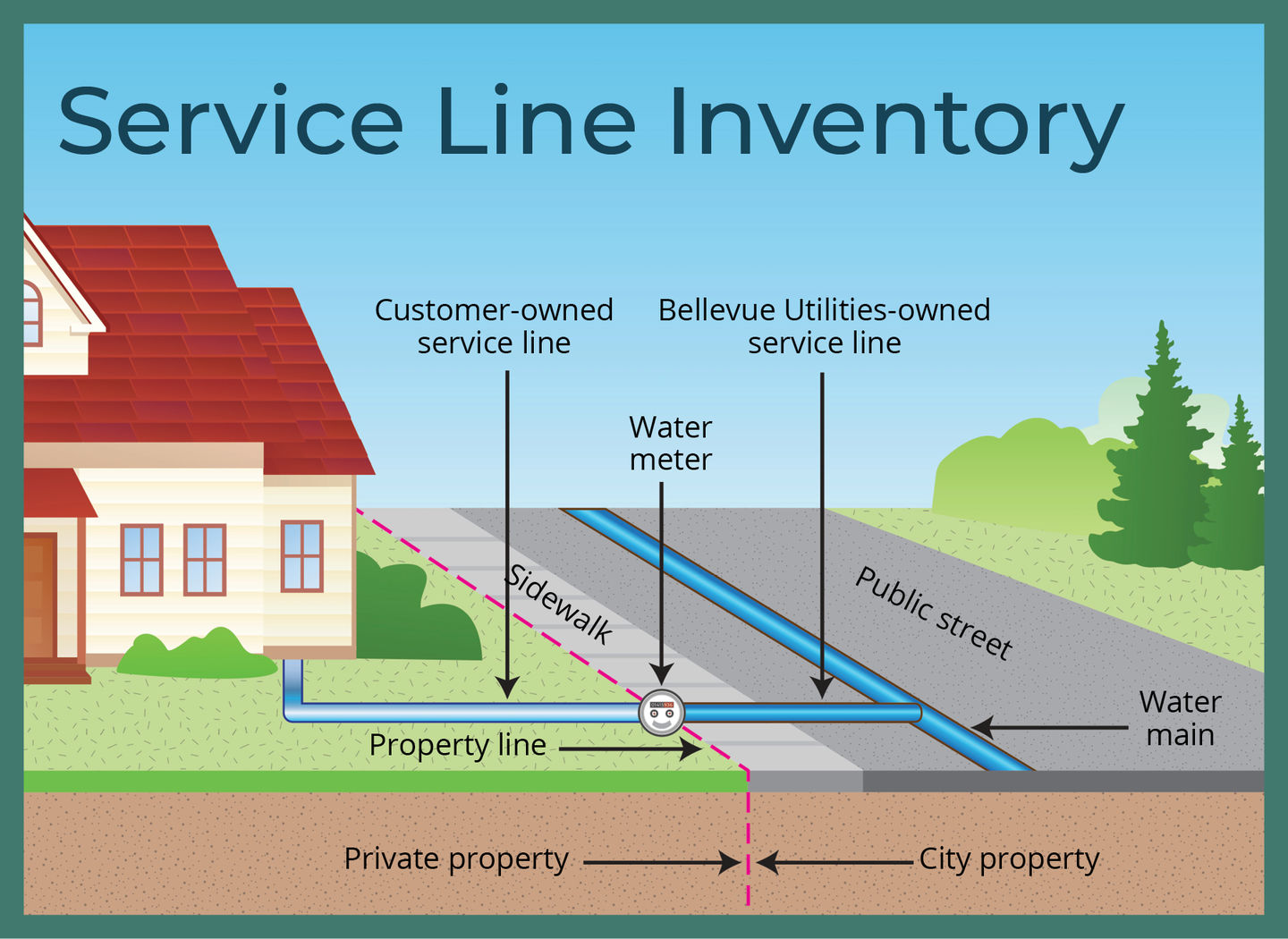The U.S. Environmental Protection Agency (EPA) requires all water utilities to perform a Lead Service Line Inventory and to provide the results by October 16, 2024. This requirement is in place to help lower the risk of exposure to lead in the nation’s drinking water.
In the image below, the service line is the smaller pipe that runs from the water main to the water meter, which is owned by Bellevue Utilities, and from the water meter to the home, which is owned by the homeowner.
Bellevue Utilities has never used lead in service lines from the water main to the water meter, and the use of lead service lines was banned in all of King County in 1968. However, homes built before 1968 could have lead pipes from the water meter to the house.
Bellevue Utilities has compiled an inventory of service lines, both owned by Bellevue Utilities and by the homeowner. However, historically Bellevue Utilities has not collected material data on the homeowner side of the service line; therefore, these will be shown as “Unknown” in the inventory. We are notifying our customers of this uncertainty. In the future, we will be working to update our data with both Bellevue Utilities side and customer side service line material information to reduce the number of unknown service line typed by material.
In 2017, 2020 and again in 2023, Bellevue Utilities conducted lead sampling from residential taps ranging from 52-68 homes in accordance with the current US EPA’s Lead and Copper Rule. On all three sampling events, none of the samples was above the action level. Occasional low-level detections are associated with customer’s fixtures and customer’s sampling techniques.
Service Line Locator
Use the above Service Line Locator online tool to find related information for homes and businesses.
How you can help. If you have additional information about your service line, such as the material or the date of replacement, please call the Utilities Department at 425-452-7840 or email Utilities Operations and Maintenance.
Information the U.S. Environmental Protection Agency and the Washington Department of Health would like you to know about lead in drinking water.
Health Effects of Lead
Exposure to lead in drinking water can cause serious health effects in all age groups. Infants and children can have decreases in IQ and attention span. Lead exposure can lead to new learning and behavior problems or worsen existing learning and behavior problems. The children of women who are exposed to lead before or during pregnancy can have an increased risk of these negative health effects. Adults can have increased risks of heart disease, high blood pressure, and kidney, or nervous system problems.*
Steps to Reduce Lead in Drinking Water
Below are recommended actions that you may take, separately or in combination, if you are concerned about lead in your drinking water. The list also includes where you may find more information. It is not intended to be a complete list. It does not imply that all actions equally reduce lead in drinking water.
- Use your filter properly. Using a filter can reduce lead in drinking water. If you use a filter, it should be certified to remove lead. Read any directions provided with the filter to learn how to properly install, maintain, and use your cartridge and when to replace it. Using the cartridge after it has expired can make it less effective at removing lead. Do not run hot water through the filter. For more information on facts and advice on home water filtration systems, visit EPA’s Filters to Reduce Lead website.
- Clean your aerator. Regularly remove and clean your faucet’s screen (also known as an aerator). Sediment, debris, and lead particles can collect in your aerator. If lead particles are caught in the aerator, lead can get into your water.
- Use cold water. Do not use hot water from the tap for drinking, cooking, or making baby formula as lead dissolves more easily into hot water. Boiling water does not remove lead from water.
- Run your water. The more time water has been sitting in pipes providing water to your home, the more lead it may contain. Before drinking, flush your home’s pipes by running the tap, taking a shower, doing laundry, or doing a load of dishes. The amount of time to run the water will depend on whether your home has a lead service line or not, as well as the length and diameter of the service line and the amount of plumbing in your home. Residents may contact us at (425) 452-7840 for recommendations about flushing times in their community.
- Learn about construction in your neighborhood. Contact us at (425) 452-7840 about any construction or maintenance work that could disturb your service line. Construction may cause more lead to be released from a lead service line or galvanized service line if present.
- Have your water tested. To find out how to conduct your own testing, please visit the Department of Ecology Lab Search to find a certified laboratory or contact us at (425) 452-7840 for more information. Note that a water sample may not adequately capture or represent all sources of lead that may be present. Visit EPA’s lead information webpage for information on sources of lead that include service lines and interior plumbing.

